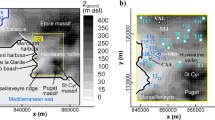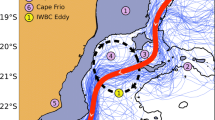Abstract
The existence of a low-level (z=~1000 m) jet adjacent to a sea-ice boundary is investigated with a two-dimensional numerical model. A thermally-direct ice breeze circulation is induced by specifying an ice-sea surface temperature gradient, with the mean geostrophic wind parallel to the ice edge. Pressure changes associated with over-water mixed-layer development create an increase in geostrophic velocity that accounts for most of the increase in wind speed. A change in initial geostrophic wind direction has significant effects on location and intensity of the low-level jet; geostrophic winds parallel to the ice edge result in stronger jets than occur with cross-ice geostrophic winds. An inertial oscillation simulated by the model in 1-D makes a negligible contribution to the low-level jet.
Similar content being viewed by others
References
Anthes, R. A., Kuo, Y-R, Benjamin, S. G., and Li, Y-F.: 1982, ‘The Evolution of the Mesoscale Environment of Severe Local Storms: Preliminary Modeling Results’, Mon. Weather Rev. 110, 1187–1198.
Blackadar, A. K.: 1957, ‘Boundary Layer Wind Maxima and their Significance for the Growth of Nocturnal Inversions’, Bull. Am. Meteorol. Soc. 38, 283–290.
Brook, R. R.: 1985, ‘The Koorin Nocturnal Low-Level Jet’, Boundary-Layer Meteorol. 32, 133–154.
Brost, R. A., Lenschow, D. H., and Wyngaard, J. C.: 1982, ‘Marine Stratocumulus Layers. Part 1: Mean Conditions’, J. Atmos. Sci. 39, 800–817.
Businger, J. A., Wyngaard, J. C., Izumi, Y., and Bradley, E. F.: 1971, ‘Flux-Profile Relationships in the Atmospheric Surfaces Layer’, J. Atmos. Sci. 28, 181–189.
Chao, S. Y.: 1985, ‘Coastal Jets in the Lower Atmosphere’, J. Phys. Ocean. 15, 361–371.
Chu, P. C.: 1986, ‘An Instability Theory of Ice-Air Interaction of the Migration of the Marginal Ice Zone’, Geophys. J. R. Astr. Soc. 86, 863–883.
Dickison, R. B. B. and Neumann, H. H.: 1982, ‘The Occurrence of Nocturnal Low-Level Jets in New England and the Canadian Maritimes’, Atmosphere-Ocean 20(4), 287–300.
Holton, J. R.: 1967, ‘The Diurnal Boundary Layer Wind Oscillation Above Sloping Terrain’, Tellus 19, 199–205.
Holton, J. R.: 1979, An Introduction to Dynamic Meteorology. 2nd Ed., Academic Press, New York, 391 pp.
Langland, R. H., Tag, P. M., and Fett, R. W.: 1987, ‘Numerical Simulation of a Satellite-Observed Calm Zone in Monterey Bay, California’, Wea. and For. 1, 261–268.
Louis, J. F.: 1979, ‘A Parametric Model of Vertical Eddy Fluxes in the Atmosphere’, Boundary-Layer Meteorol. 17, 187–202.
Malcher, J., and Kraus, H.: 1983, ‘Low-Level Jet Phenomenon Described by an Integrated Dynamical PBL Model’, Boundary-Layer Meteorol. 27, 327–343.
McNider, R. T. and Pielke, R. A.: 1981, ‘Diurnal Boundary-Layer Development over Sloping Terrain’, J. Atmos. Sci. 38, 2198–2212.
Reiter, E. R.: 1961, Jet Stream Meteorology. The University of Chicago Press, Chicago, Ill., 515 pp.
Rossby, C. G. and Montgomery, R. B.: 1935, ‘The Layer of Frictional Influence in Wind and Ocean Currents’, Papers in Phys. Ocean. and Meteor. 3, MIT and Woods Hole Ocean Inst., Woods Hole, Mass., 101 pp.
Schwerdtfeger, W.: 1972, ‘The Vertical Variation of the Wind Through the Friction-Layer over the Greenland Ice Cap’, Tellus 24, 13–16.
Shapiro, M. A. and Fedor, L. S.: 1986. The Arctic Expedition, 1984: Research Aircraft Observations of Fronts and Polar Lows Over the Norwegian and Barents Sea, Part 1. NOAA/ERL/Wave Propagation Laboratory, Boulder, CO 80303, 56 pp.
Tag, P. M.: 1979, ‘A Numerical Simulation of Fog Dissipation Using Passive Burner Lines. Part 1: Model Development and Comparison with Observations’, J. Appl. Meteorol. 18, 1442–1454.
Tag, P. M. and Payne, S. W.: 1987, ‘An Examination of the Breakup of Marine Stratus: A Three-Dimensional Numerical Investigation’, J. Atmos. Sci. 44, 208–223.
Tag, P. M. and Rosmond, T. E.: 1980, ‘Accuracy and Energy Conservation in a Three-Dimensional Anelastic Model’, J. Atmos. Sci. 37, 2150–2168.
Tag, P. M., Murray, F. W., and Koenig, L. R.: 1979, ‘A Comparison of Several Forms of Eddy Viscosity Parameterization in a Two-Dimensional Cloud Model’, J. Appl. Meteorol. 18, 1429–1441.
Zemba, J., and Friehe, C. A.: 1987, ‘The Marine Atmospheric Boundary Layer in the Coastal Ocean Dynamics Experiment’, J. Geophys. Res. 92, 1489–1496.
Author information
Authors and Affiliations
Rights and permissions
About this article
Cite this article
Langland, R.H., Tag, P.M. & Fett, R.W. An ice breeze mechanism for boundary-layer jets. Boundary-Layer Meteorol 48, 177–195 (1989). https://doi.org/10.1007/BF00121789
Revised:
Issue Date:
DOI: https://doi.org/10.1007/BF00121789




